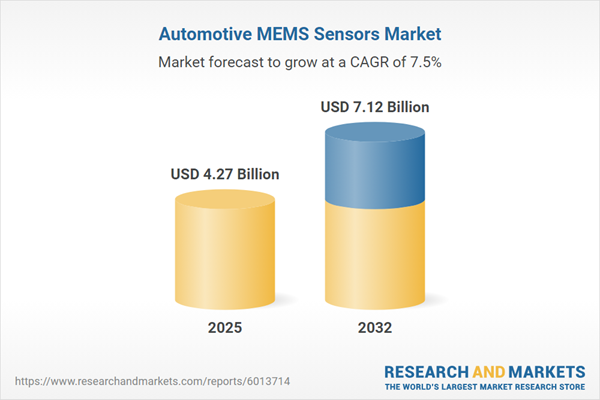Speak directly to the analyst to clarify any post sales queries you may have.
The automotive MEMS sensors market is redefining vehicle safety, efficiency, and intelligence, as technology-driven innovation shapes the future of global mobility systems for OEMs and tiered suppliers.
Market Snapshot: Automotive MEMS Sensors Market
The Automotive MEMS Sensors Market grew from USD 3.99 billion in 2024 to USD 4.27 billion in 2025. It is expected to continue growing at a CAGR of 7.48%, reaching USD 7.12 billion by 2032. This sustained growth is driven by the convergence of advanced vehicle intelligence, increasing electrification, and growing demand for robust safety and diagnostic systems across all major automotive categories.
Scope & Segmentation
This report provides detailed analyses across the full ecosystem, breaking down the market by sensor types, technology platforms, key applications, vehicle categories, end-users, and global regions.
- Sensor Types: Accelerometers, gyroscopes, magnetic sensors, pressure sensors, proximity sensors, temperature sensors.
- Technology: Analog MEMS sensors, digital MEMS sensors.
- Applications: Advanced driver assistance systems, airbag systems, autonomous vehicles, collision detection and safety systems, electric power steering, engine control and monitoring, in-vehicle infotainment, navigation systems, tire pressure monitoring systems.
- Vehicle Types: Heavy commercial vehicles, light commercial vehicles, passenger vehicles (hatchbacks, sedans, SUVs).
- End-Users: Aftermarket, original equipment manufacturers (OEMs).
- Geographic Coverage: Americas (United States, Canada, Mexico, Brazil, Argentina, Chile, Colombia, Peru), Europe (United Kingdom, Germany, France, Russia, Italy, Spain, Netherlands, Sweden, Poland, Switzerland), Middle East (United Arab Emirates, Saudi Arabia, Qatar, Turkey, Israel), Africa (South Africa, Nigeria, Egypt, Kenya), Asia-Pacific (China, India, Japan, Australia, South Korea, Indonesia, Thailand, Malaysia, Singapore, Taiwan).
- Covered Companies: Amphenol Corporation, Analog Devices Inc., Aptiv PLC, Continental AG, Delta Electronics Inc., DENSO Corporation, Hitachi Automotive Systems Ltd., Honeywell International Inc., Infineon Technologies AG, LG Innotek Co. Ltd., Maxim Integrated Products Inc., Mitsubishi Electric Corporation, Murata Manufacturing Co. Ltd., NXP Semiconductors N.V., Omron Corporation, Panasonic Corporation, Robert Bosch GmbH, Samsung Electronics Co. Ltd., Sensata Technologies Holding PLC, Skyworks Solutions Inc., STMicroelectronics N.V., TDK Corporation, TE Connectivity Ltd., Texas Instruments Incorporated.
Key Takeaways for Senior Decision-Makers
- Automotive MEMS sensors have evolved from basic accelerometers to complex, multi-functional devices fundamental to the latest vehicle systems.
- The adoption of advanced sensor technology underpins critical trends in electrification, autonomous driving, and next-generation vehicle platforms.
- Modern vehicles leverage sensor networks to deliver features such as predictive diagnostics, adaptive controls, and real-time monitoring for enhanced safety and performance.
- Intelligent sensor integration allows automakers to meet increasingly stringent regulatory and emissions standards without additional cost or reliability trade-offs.
- Distinct requirements across vehicle categories and end-user segments highlight the need for tailored solutions and flexible manufacturing approaches.
- Regional differences in regulatory mandates and R&D infrastructure drive dynamic shifts in competitive positioning and partnership strategies.
Tariff Impact and Strategic Sourcing
Recent United States tariff policies have influenced the global supply chain dynamics for automotive MEMS sensors. Additional duties on specific component sources have prompted many manufacturers to diversify production and shift sourcing strategies toward Southeast Asia and Mexico. This move, coupled with adoption of near-shoring and just-in-time strategies, allows market players to mitigate risk while maintaining cost competitiveness. Strategic alliances and cross-regional joint ventures further support local manufacturing, reinforcing supply chain resilience amid evolving trade regulations.
Primary Keyword: Automotive MEMS Sensors
Methodology & Data Sources
Research insights in this report result from a thorough, multi-phase methodology. The study integrates primary interviews with key industry stakeholders from OEMs and leading suppliers, capturing direct perspectives on technology trends, supply chain challenges, and emerging applications. Secondary research augments foundational data, using trusted sources such as peer-reviewed journals, white papers, patents, and regulatory filings. Proprietary analytical frameworks ensure the validity and depth of all market findings.
Why This Report Matters
- Equips senior executives with a forward-looking market view, supporting informed strategy and investment decisions.
- Enables procurement and product leaders to assess opportunities and risks from supply chain changes, technology innovations, and global developments.
- Offers detailed competitor and regional analyses to strengthen roadmap planning, partnership, and market entry strategies.
Conclusion
The automotive MEMS sensors market will continue shaping the evolution of mobility, enabling smarter, safer, and more efficient vehicles globally. Robust insight into market drivers, supplier actions, and regulatory shifts supports effective leadership and competitive advantage in this key segment.
Additional Product Information:
- Purchase of this report includes 1 year online access with quarterly updates.
- This report can be updated on request. Please contact our Customer Experience team using the Ask a Question widget on our website.
Table of Contents
3. Executive Summary
4. Market Overview
7. Cumulative Impact of Artificial Intelligence 2025
Companies Mentioned
The companies profiled in this Automotive MEMS Sensors market report include:- Amphenol Corporation
- Analog Devices, Inc.
- Aptiv PLC
- Continental AG
- Delta Electronics, Inc.
- DENSO Corporation
- Hitachi Automotive Systems, Ltd.
- Honeywell International Inc.
- Infineon Technologies AG
- LG Innotek Co., Ltd.
- Maxim Integrated Products, Inc.
- Mitsubishi Electric Corporation
- Murata Manufacturing Co., Ltd.
- NXP Semiconductors N.V.
- Omron Corporation
- Panasonic Corporation
- Robert Bosch GmbH
- Samsung Electronics Co., Ltd.
- Sensata Technologies Holding PLC
- Skyworks Solutions, Inc.
- STMicroelectronics N.V.
- TDK Corporation
- TE Connectivity Ltd.
- Texas Instruments Incorporated
Table Information
| Report Attribute | Details |
|---|---|
| No. of Pages | 197 |
| Published | November 2025 |
| Forecast Period | 2025 - 2032 |
| Estimated Market Value ( USD | $ 4.27 Billion |
| Forecasted Market Value ( USD | $ 7.12 Billion |
| Compound Annual Growth Rate | 7.4% |
| Regions Covered | Global |
| No. of Companies Mentioned | 25 |









